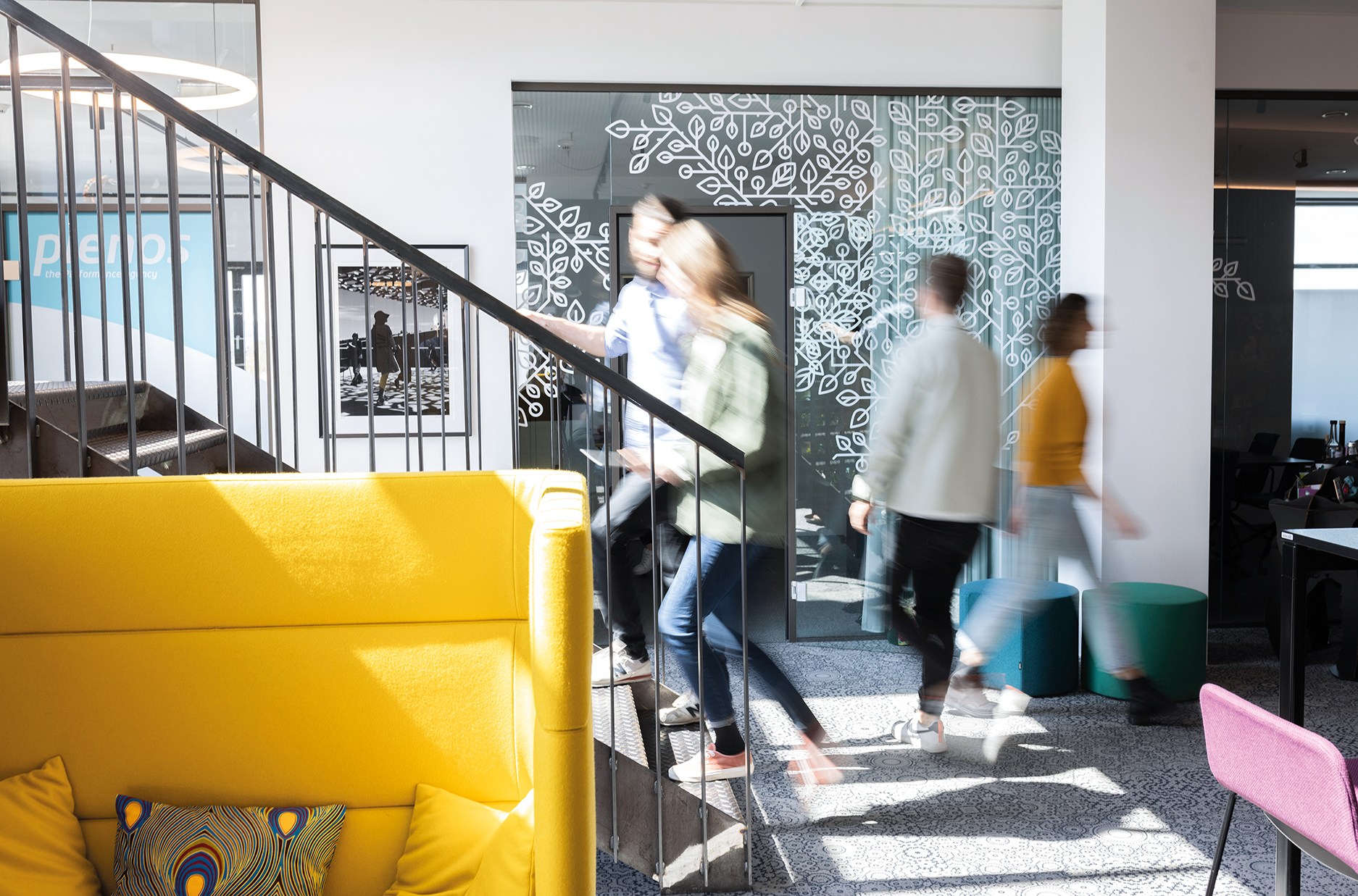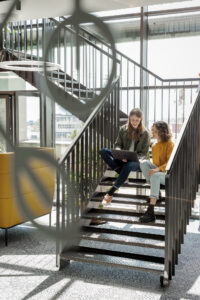Post-pandemic office design.
By Wojciech Czaja, 24.08.2022

The more we sit at home and work remote the more important it will be to create attractive places to foster team spirit and the organisation’s corporate culture. This materialises as a clear profile of requirements for the post-COVID office. And yes, this involves more than just a lobby suitable for Instagram postings.
At the beginning of the coronavirus pandemic, the OWIU Design Studio with headquarters in Los Angeles tackled the issue of how we are going to work in the future. The focus was on the development of lobbies, break rooms and conference areas where so called “social distancing” is possible. The basis for this was Le Corbusier’s “plan libre” developed in 1914: an open, flexible layout with pergolas, wooden rostra and modular room sequences will support the implementation of various types of furniture and usages. Spaciousness, height and air are thus intended to make life for the virus very uncomfortable.
The smart, photogenic renderings of OWIU’s concepts got jubilant mentions in all architecture blogs, including dezeen, archello and architizer, and was even hailed on Twitter and LinkedIn. What we do know is: The great challenge after two years of the pandemic is not how to herd everybody together with as much distance between them as possible,
but how we are going to fill the gaps in the office resulting from remote work at home. Or, as the Viennese futurologist Tristan Horx says: “A few years ago we realised that cubicles are a failure. And now we know that the classic open office propagated in the last ten years is an obsolescent model.” At present Horx is working on a book about the future of work. The 29-year-old futurologist wants to keep the title to himself. Planned date of publication: 2023. But he can let us in on this bit of information: The days of being on constant duty and permanent presence in the office are over. In future we shall differentiate whether we want to do concentrated or collective work, whether we prefer to be alone or in company. Depending on the sector, company and activity spectrum I forecast that in the long term there’ll be a remote work quotient remaining of 30 to 70 percent. The question is, however: what are we going to do with all that empty space?”
The great challenge after two years of the pandemic is not how to herd everybody together with as much distance between them as possible, but how we are going to fill the gaps in the office resulting from remote work at home.
For smaller firms, says Sabine Zinke, senior consultant at M.O.O.CON and in charge of the worlds of work division, this is not an issue. “In practice, it’s hardly possible to rent off 100 or 200 square metres of office space. But starting from a workforce of 300, the potential already exists for saving space.” While in the Erste Campus at the time of moving in, the company was still talking of a radical workplace ratio of 0.7 (meaning 7 desks for 10 full-time positions), today this value is the conventional standard in Austria. “In some companies we already calculate a ratio of 0.55 to 0.6”, says the expert. However, cutting back should not be the primary motor for change. It is far more about implementing differentiated zones for focused tasks on the one hand, and for informal, frequently spontaneous brainstorming on the other. “One of the most important tasks in future office spaces will be to provide places for chance encounters,” says Zinke. “But of course the rooms have to be equipped with the necessary technology, so as to enable digital and hybrid working with perfect, smoothly-running interfaces.”
Bernhard Kern, CEO of Roomware Consulting GmbH, thinks that employer branding will gain in significance. “We’ll have to deliver a very attractive option for strengthening communication and projecting our corporate culture if we want to entice employees back to the office as often as possible.” Important tools are high-quality IT media and an office landscape that is as heterogeneous as possible, with many different workplace options. According to Kern: “An attractive lobby suitable for Instagram postings won’t suffice, as some people seem to think.” What this office transformation might look like is evident for instance in the newly built office of ACP TEKAEF in Ried im Innkreis, Upper Austria, also the office of Pharmig (the Association of the Pharmaceutical Industry of Austria), which started operations a few months ago. The latter has reduced its size from 650 to 480 square metres “but you can hardly sense this reduction,” says Pharmig general secretary Alexander Herzog. Because on the one hand we have a shared-desk policy throughout the office, and on the other we attached importance, right from the start, to the multi-functionality of every room and every workplace.” It the boss isn’t in the building, his room is turned into a conference room at the touch of a button, which can be reserved for a meeting by means of an app.
And the coronavirus has left its traces also in banking. In the coming years the main branch of the Kärntner Sparkasse on Neuer Platz in Klagenfurt is to be completely remodelled. A workplace ratio of 0.6 will yield area reserves of unprecedented dimensions. “The coronavirus has turned the classic office concept completely upside down,” says CEO Gabriele Semmelrock-Werzer. “A major part of the team will work at home; we’ll have to get used to that, and that’s quite OK.” Our task will be to recharge the geographical location of the office with added value so that we can strengthen our team spirit also in the future, and boost our organisation’s corporate culture. We have to redefine the concept of office completely anew. An exciting task.” The office in the post-COVID age – so much is clear – has nothing to do with emptiness, troublesome viruses or perspex partitions standing around. The post-COVID office is first and foremost a hothouse of diversity, ease and interpersonal flexibility.
Wojciech Czaja





